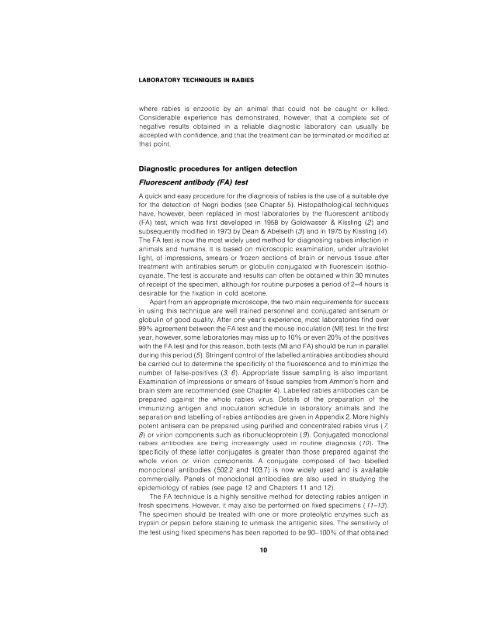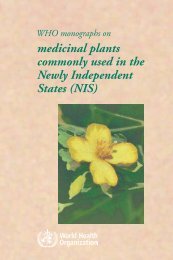in rabies - libdoc.who.int - World Health Organization
in rabies - libdoc.who.int - World Health Organization
in rabies - libdoc.who.int - World Health Organization
You also want an ePaper? Increase the reach of your titles
YUMPU automatically turns print PDFs into web optimized ePapers that Google loves.
LABORATORY TECHNIQUES IN RABIES<br />
where <strong>rabies</strong> is enzootic by an animal that could not be caught or killed.<br />
Considerable experience has demonstrated, however, that a complete set of<br />
negative results obta<strong>in</strong>ed <strong>in</strong> a reliable diagnostic laboratory can usually be<br />
accepted with confidence, and that the treatment can be term<strong>in</strong>ated or modified at<br />
that po<strong>in</strong>t.<br />
Diagnostic procedures for antigen detection<br />
Fluorescent antibody (FA) test<br />
A quick and easy procedure for the diagnosis of <strong>rabies</strong> is the use of a suitable dye<br />
for the detection of Negri bodies (see Chapter 5) Histopathological techniques<br />
have however been replaced <strong>in</strong> most laboratories by the fluorescent antibody<br />
(FA) test whicti was first developed <strong>in</strong> 1958 by Goldwasser & Kissl<strong>in</strong>g (2) and<br />
subsequeritly modified <strong>in</strong> 1973 by Dean & Abelseth (3) and <strong>in</strong> 1975 by Ksslng (4)<br />
The FA test is now the most widely used method for diagnos<strong>in</strong>g <strong>rabies</strong> <strong>in</strong>fection <strong>in</strong><br />
animals and humans It is based on microscopic exam<strong>in</strong>ation under ultraviolet<br />
light of impressions smears or frozen sections of bra<strong>in</strong> or nervous tissue after<br />
treatment with anti<strong>rabies</strong> serum or globul<strong>in</strong> conjugated with fluoresce<strong>in</strong> isothio<br />
cyanate The test is accurate and results can often be obta<strong>in</strong>ed with<strong>in</strong> 30 m<strong>in</strong>utes<br />
of receipt of the specimen although for rout<strong>in</strong>e purposes a period of 2-4 hours is<br />
desirable for the fixation <strong>in</strong> cold acetone<br />
Apart from an appropriate microscope the two ma<strong>in</strong> requirements for success<br />
<strong>in</strong> us<strong>in</strong>g this technique are well tra<strong>in</strong>ed personnel and conjugated antiserum or<br />
globul<strong>in</strong> of good quality After one year S experience most laboratories flnd over<br />
99% agreement between the FA test and the mouse <strong>in</strong>oculation (MI) test In the first<br />
year however some laboratories may miss up to 10% or even 20% of the positives<br />
with the FA test and for this reason both tests (M1 and FA) should be run <strong>in</strong> parallel<br />
dur<strong>in</strong>g this period (5) Str<strong>in</strong>gent control of the labelled ant<strong>rabies</strong> antibodies should<br />
be carried out to determ<strong>in</strong>e the specficity of the fluorescence and to m<strong>in</strong>imize the<br />
number of false-positives (3 6) Appropriate tlssue sampl<strong>in</strong>g is also important<br />
Exam<strong>in</strong>ation of impressions or smears of tissue samples from Amrnon s horn and<br />
bra<strong>in</strong> stem are recommended (see Chapter 4) I abelled <strong>rabies</strong> antibodies can be<br />
prepared aga<strong>in</strong>st the <strong>who</strong>le <strong>rabies</strong> virus Details of the preparation of the<br />
immunizrig antigen and <strong>in</strong>oculation schedule <strong>in</strong> laboratory animals and the<br />
separation and abellirig of rdbies aritibodies are given iri Appendix 2 More highly<br />
potent antisera can be prepared us<strong>in</strong>g purified and concentrated <strong>rabies</strong> virus (7<br />
8) or virion components such as ribonucleoprote<strong>in</strong> (9) Conjugated monoclonal<br />
<strong>rabies</strong> antibodes are be<strong>in</strong>g <strong>in</strong>creas<strong>in</strong>gly used <strong>in</strong> rout<strong>in</strong>e diagnosis (10) The<br />
specficity of these latter conjugates IS greater than those prepared aga<strong>in</strong>st the<br />
<strong>who</strong>le vlrlon or virion components A conjugate composed of two labelled<br />
monoclonal antibodies (502 2 and 1037) is now wdey used and is ava~lable<br />
commercially Panels of monoclonal antibodies are also used <strong>in</strong> study<strong>in</strong>g the<br />
epidemiology of <strong>rabies</strong> (see page 12 and Chapters 11 and 12)<br />
The FA technique is a tighly sensitive method for detect~ng <strong>rabies</strong> antigen <strong>in</strong><br />
fresh specimens However it may also be periormed on fixed specimens ( 11-73)<br />
The specimen should be treated with one or more proteolytc enzymes such as<br />
Lrypsirl or pepsiri before stairl<strong>in</strong>g to unmask the antigenic sites The sensitivity of<br />
the test us<strong>in</strong>g fixed specimens has been reported to be 90-10090 of that obta<strong>in</strong>ed
















